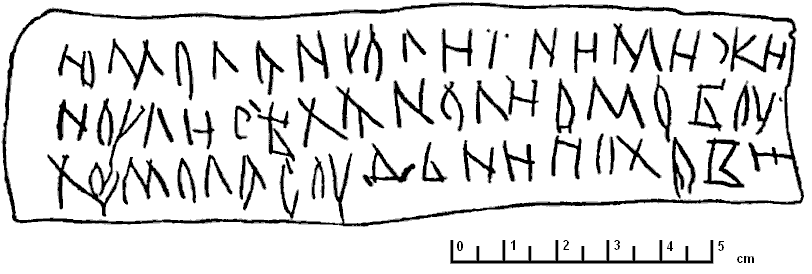|
Birch bark letter no. 292 Birch bark letter no. 292 is a birch bark letter that is the oldest known document in any Finnic language.[1] The document is dated to the beginning of the 13th century and is written in the Cyrillic script.[2] It was found in 1957 by a Soviet expedition led by Artemiy Artsikhovsky in the Nerevsky excavation on the left coast side of Novgorod.[3] It is currently held at the Novgorod City Museum. The language used in the document is thought to be an archaic form of Livvi-Karelian, the language spoken in Olonets Karelia,[4] although the exact form is difficult to determine, as Finnic dialects were still developing during that period. TranscriptionThe text is written in Cyrillic in a Finnic language variety that is closer to modern Karelian or Veps.[2] A transcription of the text is as follows:[5]
InterpretationsBy Yuri YeliseyevThe text, as transliterated to the Latin alphabet by Yuri Yeliseyev in 1959[6] and interpreted in modern Finnish: jumolanuoli ï nimizi Jumalannuoli, kymmenen [on] nimesi In English, this means roughly the following:
Yeliseyev believes, that this is an invocation against lightning, as evidenced by "ten your names" construction. According to superstitious notions, knowledge of the name gives a human the magic power over an object or phenomenon.[7] By Martti HaavioAs the orthography used does not utilize spaces between words, the source text can be transcribed into words in different ways. Martti Haavio gives a different interpretation of the text in his 1964 article, suggesting, that this is a sort of an oath: jumolan nuoli inimizi In modern Finnish, this means roughly the following: Jumalan nuoli, ihmisen In modern Estonian, this means roughly the following: Jumala nool, inimese In English, this means roughly the following:
By Yevgeny KhelimskyProfessor Yevgeny Khelimsky in his 1986 work[8] criticizes Haavio's interpretation and gives the third known scientific interpretation, believing the letter to be an invocation, like Yeliseyev:[7] Jumalan nuoli 10 nimezi A translation into Finnish of this interpretation would look something like this: Jumalan nuoli 10 nimesi In English, it means roughly the following:
†Syyttö-Jumala could also mean "Blaming God" or "God that blames"; modern Finnish syyttää = to blame or prosecute. See alsoReferences
Sources
External links
|
